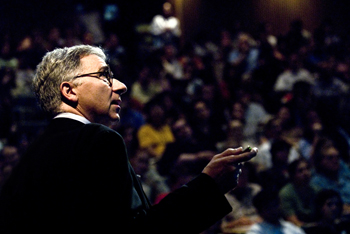
Douglas Melton, Ph.D., delivers this fall’s first Discovery Lecture to a packed crowd at Light Hall. (photo by Susan Urmy)
Lecturer issues challenge for stem cell researchers

Forget the plastic surgery and home renovation featured on TV. In the ultimate “Extreme Makeover,” one kind of cell will be turned into another to reverse diseases like diabetes.
During last week's Discovery Lecture, Douglas Melton, Ph.D., co-director of the Harvard Stem Cell Institute, described three ways to make new insulin-producing beta cells, which are destroyed by the immune system in patients with type 1 diabetes.
One way is to boost replication in the pancreas of pre-existing beta cells. Another is to generate new beta cells from embryonic stem cells or from induced pluripotent stem (iPS) cells, adult cells that have been “induced” to revert to an embryonic-like state of “pluripotency” in which they can turn into any other kind of cell.
A third is “direct reprogramming,” turning one kind of cell into another without needing to “turn back the clock” into an embryonic-like state. Melton said his children, both of whom have type 1 diabetes, call this approach “extreme makeover.”
“We don't yet know what's the best way to make new beta cells,” Melton told a rapt audience in an overflowing Light Hall lecture room. But all three approaches “have real juice in them, projects that could be squeezed to move forward this field of regenerative medicine.”
The first avenue — boosting replication of pre-existing beta cells — is still in its infancy. Much needs to be learned about what triggers beta cells to divide.
Further along is the study of human embryonic stem cells, although progress has been slowed by restrictions on the use of federal funds in this area.
As for reprogramming adult cells, Melton and his colleagues made waves in August with a report that they had converted one type of pancreas cell into an insulin-secreting cell by “switching on” three transcription factors normally involved in pancreatic development.
The finding raises the possibility that cells in other tissues, from the lung to the nervous system, also can be reprogrammed.
“One should think about all of the diseases of cellular deficiency where there are neighboring cells that might be quite healthy,” he said. “For example, ALS — Lou Gehrig's disease — where the motor neurons are defective but the associated astrocytes and glia may be fine. Could one find a set of transcription factors that would convert those into useful motor neurons?”
Melton invited young scientists in the audience to join him in trying to solve the mysteries of regeneration, as well as the riddle of auto-immunity that causes type 1 diabetes.
“I don't think this is a project that will be solved within a year,” he said, “but if you're looking for a grand project that will take a decade or more you are welcome to come join us.”
Melton's talk, the Irwin B. Eskind Lecture, was sponsored by the Vanderbilt Diabetes Research and Training Center and named for the late physician, philanthropist and graduate of Vanderbilt and VUSM.
For a complete schedule of the Discovery Lecture Series and archived video of previous lectures, go to www.mc.vanderbilt.edu/discoveryseries.













